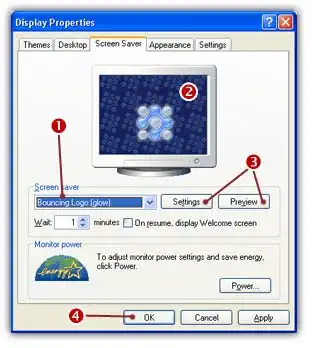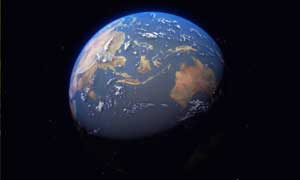What is a Screensaver?
In relation to Axialis Screensaver Producer, this article offers information on the following topics:
- What is a Sprite-based screensaver?
- What is a Slideshow-based screensaver?
- What is a Video-based screensaver?
- What are the characteristics of a Windows screensaver?
- How to install a screensaver on a Windows computer?
- How to uninstall a screensaver?
Axialis Screensaver Producer is a powerful tool designed to create Windows screensavers. But what is a screensaver? It is an animated screen that is activated on a personal computer display when no user activity has been sensed for a certain time. The original purpose of a screensaver was to prevent burn-in (the burning of an image into the phosphor inside the cathode ray tube after hours of the same image being displayed). In fact, today's CRT/LCD display technology makes burn-in unlikely except under extreme conditions. The perfect screensaver is the black screen... a bit boring, huh? Many people get screensavers so that something interesting is on the screen when they make a pause. Screensavers are also a good way to promote a company or a product.
Windows comes with built-in screensavers that you can select. If you purchase your computer with the operating system already installed, a screensaver may have been selected for you. Also, many screensavers can be downloaded from specific sites (search "free screensaver" from Google). Of course, the best way is to create your own and express your talent...
A state-of-the-art screensaver must have the following characteristics:
- A dark background or scene - This is to save power consumed by the display.
- Moving objects or scene - This is to avoid pixel burning. Fixed objects must be dark.
- Slow motion - The scene must be appeasing.
- Silent - If you add sounds, use low-level ones and/or cool music.
- Sensitive - It must stop on any user action (mouse move, click, keyboard hit...).
What is a Sprite-based screensaver?
A sprite is an animated or fixed object which moves or is static on screen. As the goal of a screensaver is to save screen pixels, it is better to use moving sprites (see "bouncing balls" example). Sprites can move on screen, be static, be animated (a spinning ball for example, composed of several images), bounce on the edge of the screen, collide with other sprites and more. The Sprite based screensaver is the most commonly used.
Here are a few examples created with Axialis Screensaver Producer that you can download:
Company Logo
Shows how you can create a screensaver using a company logo image.
This simple screensaver contains one single sprite that moves horizontally at constant speed over a black background. The sprite size is 60% of the original picture but it is resized proportionally to the final screen.
This screensaver is a sample project that is included in Axialis Screensaver Producer. You can simply open and modify it to create your own version of this screensaver
Company Gears
Shows how you can create a screensaver using a company logo image with animated objects in background.
In background, several sprites are rotating in place at different speeds. They have a very low opacity value to create a watermark effect. The screensaver uses the hardware acceleration of the video card to make objects spinning.
This screensaver is a sample project that is included in Axialis Screensaver Producer. You can simply open and modify it to create your own version of this screensaver
I Love You 2023
Shows how you can create a lovely screensaver with a static text and many rotating and moving sprites in background.
42 sprites are 'blowing' and moving/spinning in random directions. The screensaver uses the hardware acceleration of the video card to make many objects spinning and moving without latency.
This screensaver is a sample project that is included in Axialis Screensaver Producer. You can simply open and modify it to create your own version of this screensaver
Space Cartoon
Shows how you can create a funny screensaver with a swingging and moving sprites in background.
Several sprites are swingging and moving in random directions. A large sprite in background rotates to create a rays-of-light effect. The screensaver uses the hardware acceleration of the video card to make many objects spinning and moving without latency.
This screensaver is a sample project that is included in Axialis Screensaver Producer. You can simply open and modify it to create your own version of this screensaver
Smiley Party
Shows how you can create a funny screensaver with a swingging and moving sprites.
Several sprites are swingging and moving/spinning in random directions. A background music creates a party effect. Smileys are bouncing on each others. The screensaver uses the hardware acceleration of the video card to make many objects swingging and moving without latency.
This screensaver is a sample project that is included in Axialis Screensaver Producer. You can simply open and modify it to create your own version of this screensaver
What is a Slideshow-based screensaver?
A slideshow is a sequence of full screen images, each one loading the next. Each image is called a "slide". Each slide is displayed on screen for a specified period of time. When this period is over, the next slide is displayed using a possible transition effect (cut, roll, fade...). A background music can be added as well as a startup video sequence. This kind of screensaver is great to display your vacation photos or promote a company slogan for example.
Here is an example created with Axialis Screensaver Producer that you can download:
The Beauty of Nature
This sample shows how you can create a slideshow screensaver. The images are displayed in Zoom mode (the background is never visible and the aspect ratio of the images is respected on all screen formats). A watermark has been added in the lower-right corner (using the screensaver feature, not hard-written in the images).
Photos by Larisa Koshkina - ©2022 all rights reserved. Pictures were downloaded via Pixabay and resized for the screensaver. If you want to get more pictures or full resolution versions you can visit Pixabay or contact Larisa Koshkina at: https://pixabay.com/users/larisa-k-1107275
What is a Video-based screensaver?
A video screensaver permits displaying a list of video clips full screen in sequence. This kind of screensaver is less used but could be useful to display a company advertisement clip for example.
Here is an example created with Axialis Screensaver Producer that you can download:
Earth
This sample screensaver projects shows how to create an endless movie screensaver based on a loop video clip. The movie is displayed fullscreen in zoom mode (no background displayed on all screen formats).
Video by Seb Agora - ©2022 all rights reserved. The video file was downloaded via Pixabay and optimized for the screensaver. If you want to get more videos or full resolution versions you can visit Pixabay or contact Seb Agora at: https://pixabay.com/users/seb_agora-13890949
What are the characteristics of a Windows screensaver?
First of all, a screensaver is a program. It is in fact an executable file which have the SCR extension (not EXE). Windows SCR screensavers can be executed in 3 modes:
- Full Screen mode - This is the default mode. If you launch a SCR file from Windows Explorer, it will display full screen.
- Configure mode - Specify "/C" of right-click on the file using Windows Explorer and select "Configure". The screensaver built-in dialog box opens and permits adjusting various settings.
- Preview mode - This mode is reserved to Windows. When launched in this mode, the screensaver displays in small size in the Windows Display Properties dialog box (see below).
SCR files can be located anywhere on your hard disks but we recommend you to copy them in your Windows system directory (see below how to install a screensaver).
How to install a screensaver on a Windows computer?
If an install procedure is provided with the screensaver, just install it launching the procedure. When a screensaver is distributed as a simple SCR file, You have to follow this procedure to install it on a computer:
1. Copy the SCR file in your system folder "C:\WINDOWS\SYSTEM32"
2. Right-click in the Windows Desktop background and select "Properties". A dialog box opens. Select the "Screensaver" tab:

3. Select your screensaver in the list 1. (it should appear in this list if you copied it in the correct folder). The screensaver appears in the Preview screen 2.
4. You can adjust the screensaver settings or display it full screen 3.
5. When all done, click OK 4.
How to uninstall a screensaver?
If an uninstall procedure is provided with the screensaver, just uninstall it launching the procedure. When a screensaver is distributed as a simple SCR file, you have to locate the SCR file and delete it. You can also choose another screensaver (or simply specify "None") in the above list 1.












